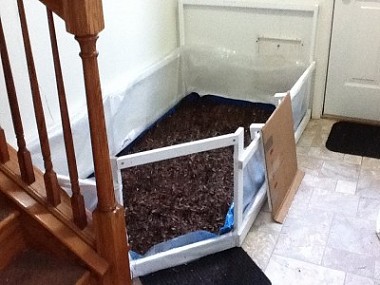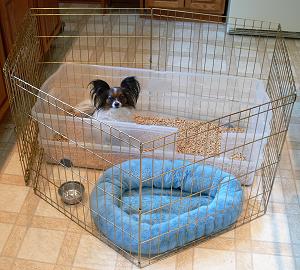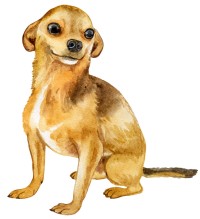Teach Your Pup to Go to the Bathroom Indoors (Newspapers or Litterbox)
By Michele Welton, Dog Trainer, Breed Selection Consultant, Author of 15 Dog Books
If you skipped ahead to this article, please go back and read the previous article on Housebreaking Basics. Important stuff there!
CAUTION: Encouraging a dog to eliminate on newspapers or in a litterbox is teaching him to eliminate inside your house.
 If you're planning to let him do this throughout his life, that's fine. But some owners only want their dog to "go" indoors when he's very young. Then they want him to switch to going outdoors.
If you're planning to let him do this throughout his life, that's fine. But some owners only want their dog to "go" indoors when he's very young. Then they want him to switch to going outdoors.
Yes, many dogs can make that transition, but some dogs get confused. So be aware that it might not be as easy as you think to first tell your pup he can "go" in the house, then later tell him he can't. Put yourself in your dog's place and you can see the potential for confusion.
When you don't have a choice:
Sometimes your hand is forced. Maybe you work all day. Maybe you're disabled. Or maybe you live in a high-rise or your weather is rotten much of the time, and you simply can't take your pup outside every couple of hours all through the day and evening.
In such cases, you need to provide constant access to a bathroom spot.
- This might be a small potty yard outdoors which your pup can access through a doggy door. But not if you work all day! Bark bark bark!
- Or it can be an indoor bathroom. This article is about providing an indoor bathroom for your (small) dog.
Indoor bathroom options
Let's start with a quick list. I'll explain more about each option in a minute. An indoor bathroom can be.....
- a small fenced area indoors, filled with pine bark mulch (untreated & undyed) or recycled cat litter (not clumping litter, which is dangerous). If you have space for this, it's the most natural option for a dog because he can walk around, sniffing, as though he were outdoors.
- a plastic litterbox. For very tiny dogs, this could be a large plastic storage bin (not a cat litterbox, which is too small). Tiny-to-small dogs dogs might need a plastic kiddie pool.
- "pee pads" or weewee pads, which are soft pads impregnated with a chemical that encourages dogs to pee on them.
- newspapers spread on the floor.
Let's talk about each of those options.
Indoor potty yard
Here is an example of a homemade potty yard in a mud room with vinyl flooring. A heavy tarp was laid on the vinyl, then a couple of inches of mulch was laid on top of the tarp. The yard is scooped every day and the mulch completely changed every 3-4 weeks.

The sides of the yard are high and plastic-covered, because some dogs will back up to the wall of a confined area and leave their solid deposits against the wall. Yuck. And if the walls are too short, those deposits might end up OVER the wall. Double yuck.
Notice the homemade cardboard "gate", which can be hung over the entrance if you need to confine the pup in the potty yard for a few minutes to make sure he goes. This might be utilized during the training period, but usually isn't needed beyond that.
I should mention that indoor bathrooms work better for female dogs or for males (usually neutered) who squat to pee. Males who lift their leg can spray urine everywhere! With leg-lifting males, the yard definitely needs very high sides covered with plastic. Some DIY owners install a vertical "pee pole" (covered with plastic) in the center of the yard for their leg-lifting male.
Indoor litter box
Now I'll be the first one to admit that an indoor potty yard is not the loveliest thing to look at! A regular litter box, like a cat's box, looks more appealing.
Unfortunately, most dogs don't like to "go" in such a small area. If you've ever watched a dog hunting for the right bathroom spot, you know they like to wander around in circles and sniff.
So litter boxes work best for truly tiny dogs such as Chihuahuas, Maltese, and Yorkies. Even then, the bigger the box, the better. As with potty yards, the sides of the box should be quite high, or else you may find stools eliminated over the edge and onto your floor. A regular cat box is too shallow for dogs.
I recommend making your own box from a large, deep, plastic storage bin. Cut a squared-off U-shape in one side to make a step-over entrance, leaving enough of the box below the entrance to hold the litter in the box.

In the picture you can see a plastic storage bin being used as a litterbox. Actually, it's TWO storage bins, one stacked on top of the other. The lower bin is intact, while the upper bin had its bottom cut out of it, then its four walls were hot-glued onto the lower box to make the whole unit taller.
Warning: Don't use clumping kitty litter!
Clumping litter hardens into a compact little ball when it gets wet, (i.e. when urine soaks into it). Clumping litter is easy to scoop up and less wasteful of litter, compared to the old traditional clay litter.
Unfortunately, we now know that when a dog or cat licks clumping litter off its paws or coat and swallows it, the litter gets wet (from saliva and stomach fluid). Then it can clump inside him and block his internal "pipes". You can find out more about the dangers of clumping kitty litter by doing a Google search.
So what kind of litter should you use? I recommend litter made from non-clumping pellets of recycled paper or wood fibers. A popular brand is Feline Pine but there are many others.
Commercial litter boxes
Some companies market so-called litter box "systems". You know how manufacturers of computer printers will sell you a printer for peanuts because they make their real money off the replacement ink cartridges?
Similarly, the makers of litter box systems will sell you the box for a reasonable fee because they make their real money off the replacement "turf" that goes inside the box. The turf might be natural grass, or it might be artificial like indoor/outdoor carpeting.
Typically, the photos of such systems show a flat surface that resembles a miniature golf putting green, with no sides or walls to speak of. So unless your dog happens to go right in the middle, I would expect an awful lot of "misses" and a messy floor around the box. But I can't speak from experience, so....
Pee Pads
 Also called wee wee pads or housetraining pads, these swatches of cloth come pretreated with a chemical that resembles urine, which (sort of) encourages pups to pee on them.
Also called wee wee pads or housetraining pads, these swatches of cloth come pretreated with a chemical that resembles urine, which (sort of) encourages pups to pee on them.
I dislike these pads immensely.
- I dislike them because they're tossed on the floor, then the pup is allowed to wander loose and is expected to find the pad whenever he needs to "go." This is unrealistic for most young pups and sets them up for failure.
- I dislike them because they're too small. Dogs like to sniff and circle around to find just the right spot. It's unrealistic to expect a pup to find the center of a small cloth and eliminate such that the entire deposit hits that small space.
- And I dislike them because they encourage a dog to pee or poop on soft things.... like carpets, sofa cushions, and the blankets on your bed.
When I'm called upon to solve housebreaking issues, I often find that these pads are in use, or have been in use. In my experience, they cause more problems than they solve.
Newspapers spread on the floor
Finally, newspapers are an old, traditional method of housebreaking – I used it with my second German Shepherd pup and it worked fine.
But it's not without its problems, the main one being that owners often want their pup to go on newspapers when he's young, then start going outdoors when he gets older.
This works okay for some dogs, but confuses others. So before you start laying down newspapers, be sure you're prepared to deal with potential housebreaking confusion in the future. You mustn't punish a legitimately confused dog.
Instead, to make this transition from indoors to out, you should pick up all the newspapers and go straight to the crate-training or doggy-door method.
How to teach your pup to use an indoor bathroom
Give him constant access to his bathroom. The best way to do that is to wrap an exercise pen snugly around his indoor potty yard, litterbox, or newspapers.
Until he is fully housebroken, your pup should stay in the pen all the time – unless you're sitting with him, playing with him, walking him, grooming him, or otherwise fully interacting with him. This ensures that he never has the chance to learn or practice bad habits on the floors of your house.
An alternative to using an ex-pen is to confine the pup to a small laundry or mudroom blocked by a baby gate. Such a room works okay with newspapers because they're spread everywhere, so the pup can't "miss" going on them. A room works less well with a litterbox because with more free space, the pup can easily go on the floor outside the box.
Here's an example of teaching a dog to use a litterbox enclosed in a pen

- Shape the exercise pen tightly around the litter box so the box fills the entire pen except for a small blanket/bed with a toy on it, and a water bowl. Leave no open space. Most pups don't want to soil their bed, so they will almost always go in the box if you give them no other open space.
- Place your pup in the pen. Stop any barking.
- Once he's calm and quiet, occasionally encourage him to step into the litter box by holding a treat in front of his nose and leading him in. Once there, praise and give him the treat. It's okay if he steps right back out. You simply want him to get used to stepping in the box and associating it with good things.
- Whenever you see him step into the box on his own, even to play, praise him. "Yes. Good boy." But don't get him all revved up! If you actually see him go to the bathroom, that's the time to praise with enthusiasm and give a treat!
- After he has been using the box reliably for a week or so, expand the size of the pen just a little so he has a little more room to play. If he eliminates on the newly-open floor inside the pen, immediately shrink the pen again and give him another few days of practice before you try expanding again.
Remember, while you're housebreaking him, he should be outside the pen only when you're interacting with him: feeding, grooming, walks, playtime, etc. At no point should he be walking freely around the house.
My best-selling books – now available FREE on my website
 Respect Training For Puppies: 30 seconds to a calm, polite, well-behaved puppy is for puppies 2 to 18 months old. Your puppy will learn the 21 skills that all family dogs need to know. Click here to read for free.
Respect Training For Puppies: 30 seconds to a calm, polite, well-behaved puppy is for puppies 2 to 18 months old. Your puppy will learn the 21 skills that all family dogs need to know. Click here to read for free. Teach Your Dog 100 English Words is a unique Vocabulary and Respect Training Program that will teach your adult dog to listen to you and do what you say. Click here to read for free.
Teach Your Dog 100 English Words is a unique Vocabulary and Respect Training Program that will teach your adult dog to listen to you and do what you say. Click here to read for free. 11 Things You Must Do Right To Keep Your Dog Healthy and Happy helps your dog live a longer, healthier life. Get my honest advice about all 11 Things before you bring home your new puppy, because some mistakes with early health care cannot be undone. Click here to read for free.
11 Things You Must Do Right To Keep Your Dog Healthy and Happy helps your dog live a longer, healthier life. Get my honest advice about all 11 Things before you bring home your new puppy, because some mistakes with early health care cannot be undone. Click here to read for free.
